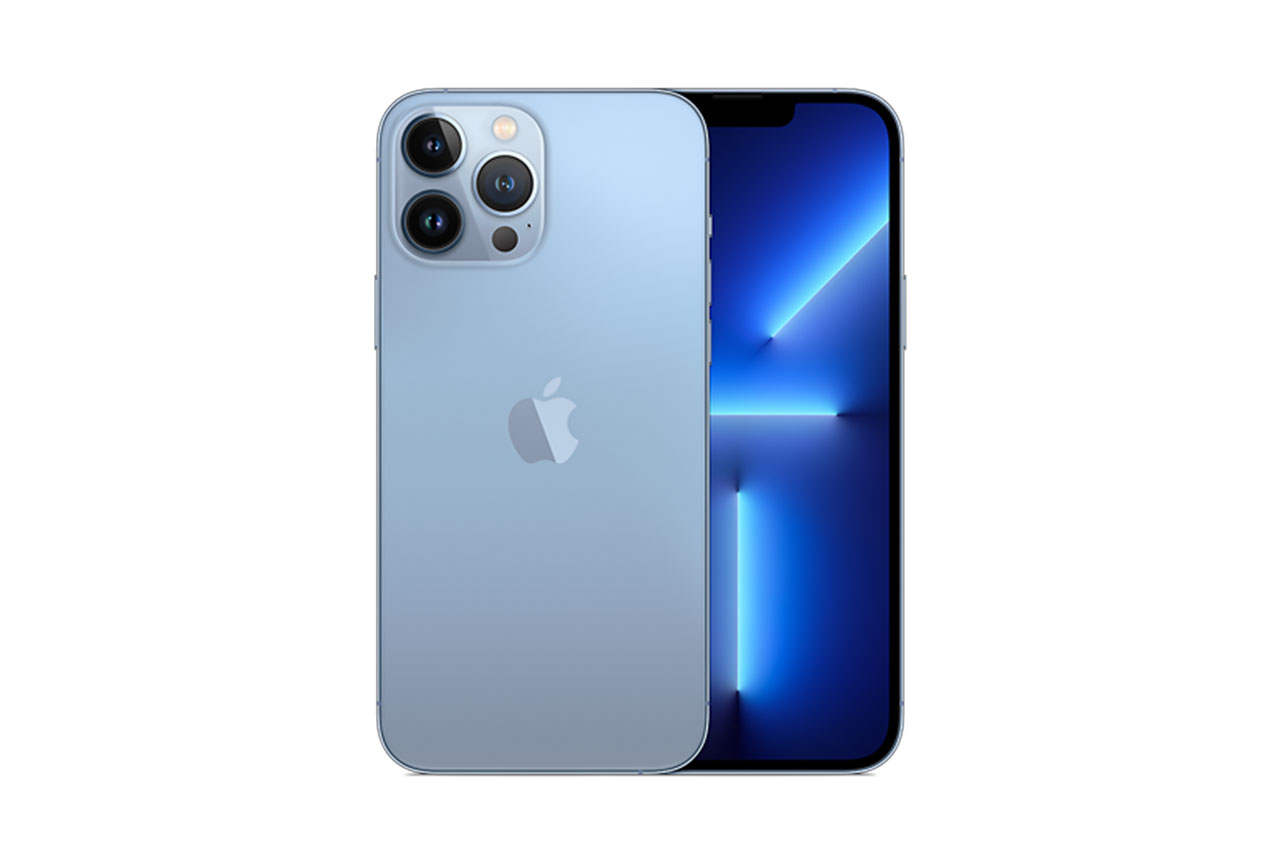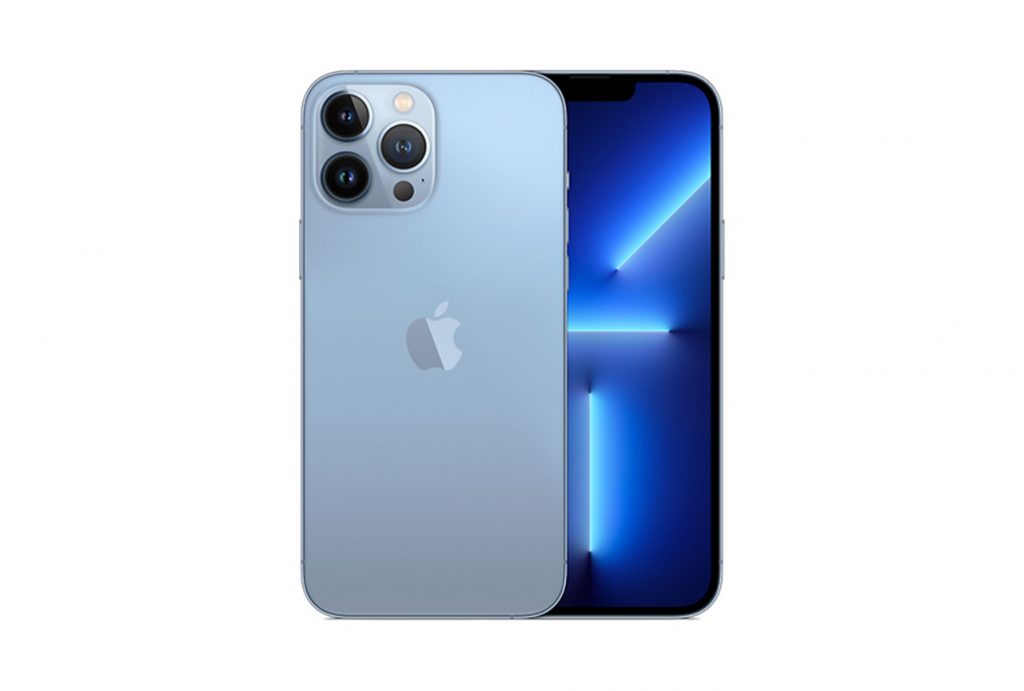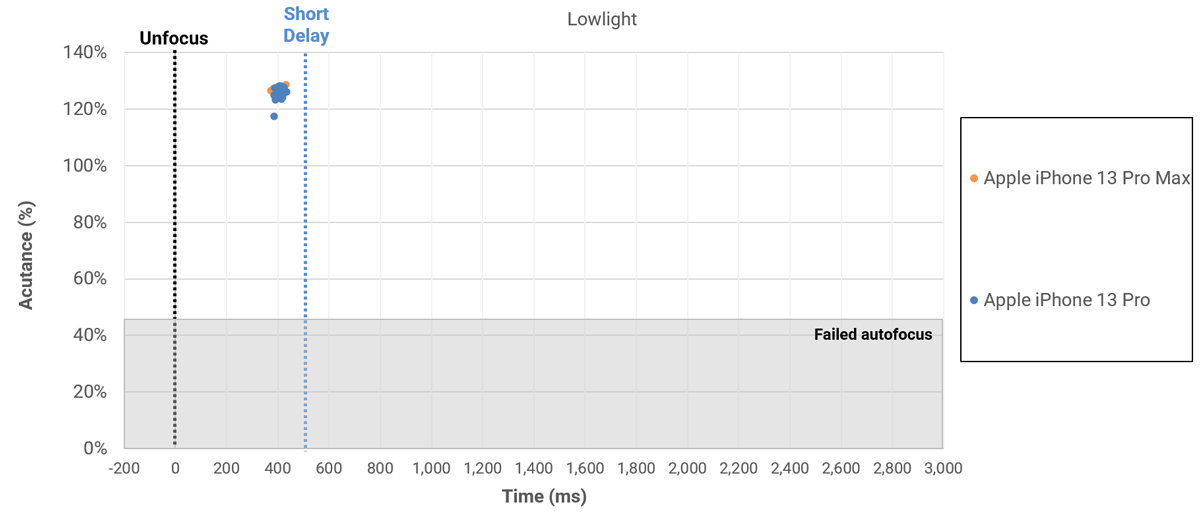The iPhone 13 Pro Max is the largest and most expensive model in Apple’s 2021 smartphone line-up and features a 6.7-inch Super Retina XDR display with 1284 x 2778 pixels resolution. Like the smaller iPhone 13 Pro, it is powered by Apple’s latest A15 Bionic chipset and comes with up to 1TB of internal storage.
Both models also use the same camera setup that now comes with a larger sensor and faster aperture in the primary cam, compared to last year’s 12 Pro and Pro Max models. On the ultra-wide sensor, size remains unchanged but there’s also a faster aperture plus a PDAF autofocus system versus the fixed-focus lens on the iPhone 12 series. On the tele camera, Apple has increased the reach, and the models now offer a 3x optical magnification compared to the primary camera.
Read on to find out how the all-new iPhone 13 Pro Max camera performed in our DXOMARK Camera tests.
Overview
Key camera specifications:
- Primary: 12 MP sensor, 1.9µm pixels, 26 mm equivalent f/1.5-aperture lens, sensor-shift OIS, Dual Pixel AF
- Ultra-wide: 12MP sensor, 13mm equivalent f/1.8-aperture lens, PDAF, 2cm macro
- Tele: 12 MP sensor, 77 mm equivalent f/2.8-aperture lens, OIS
- 3D sensor
- 4K at 24/25/30/60 fps, 1080p at 25/30/60 fps, HDR video recording with Dolby Vision
- Cinematic mode for recording videos with shallow depth of field (1080p at 30 fps)
Scoring
Sub-scores and attributes included in the calculations of the global score.
 Apple iPhone 13 Pro Max
Apple iPhone 13 Pro Max

141
camera
110
Huawei Pura 70 Ultra
Best: Huawei Pura 70 Ultra (130)
115
Apple iPhone 16 Pro
Best: Apple iPhone 16 Pro (130)
111
Huawei Pura 70 Ultra
Best: Huawei Pura 70 Ultra (125)
106
Xiaomi 15 Ultra
Best: Xiaomi 15 Ultra (125)
87
Huawei Pura 70 Ultra
Best: Huawei Pura 70 Ultra (117)
71
Xiaomi Redmi 12 5G
Best: Xiaomi Redmi 12 5G (82)
75
Huawei Pura 70 Ultra
Best: Huawei Pura 70 Ultra (85)
81
Apple iPhone 16 Pro
Best: Apple iPhone 16 Pro (93)
87
Xiaomi 15 Ultra
Best: Xiaomi 15 Ultra (128)
89
Huawei Pura 70 Ultra
Best: Huawei Pura 70 Ultra (122)
115
Oppo Find X8 Pro
Best: Oppo Find X8 Pro (116)
115
Oppo Find X8 Pro
Best: Oppo Find X8 Pro (120)
115
Huawei Pura 70 Ultra
Best: Huawei Pura 70 Ultra (120)
111
Oppo Find X6 Pro
Best: Oppo Find X6 Pro (118)
116
Apple iPhone 16 Pro
Best: Apple iPhone 16 Pro (120)
73
Xiaomi 12S Ultra
Best: Xiaomi 12S Ultra (86)
112
Apple iPhone 16 Pro
Best: Apple iPhone 16 Pro (119)
Use cases & Conditions
Use case scores indicate the product performance in specific situations. They are not included in the overall score calculations.
Outdoor
Photos & videos shot in bright light conditions (≥1000 lux)
Indoor
Photos & videos shot in good lighting conditions (≥100lux)
Lowlight
Photos & videos shot in low lighting conditions (<100 lux)
Friends & Family
Portrait and group photo & videos
Position in Global Ranking

34
th
4. Apple iPhone 16 Pro Max
157
10. Apple iPhone 15 Pro Max
154
22. Honor Magic4 Ultimate
147
26. Apple iPhone 14 Pro Max
146
26. Motorola Edge 50 Ultra
146
26. Samsung Galaxy S25 Ultra
146
32. Samsung Galaxy S24 Ultra
144
34. Apple iPhone 13 Pro Max
141
34. Google Pixel 9 Pro Fold
141
38. Samsung Galaxy S23 Ultra
140
43. Tecno Camon 40 Pro 5G
138
45. Vivo X80 Pro (Snapdragon)
137
52. Samsung Galaxy S22 Ultra (Snapdragon)
135
52. Vivo X80 Pro (MediaTek)
135
59. Samsung Galaxy Z Fold6
133
59. Samsung Galaxy S24+ (Exynos)
133
59. Samsung Galaxy S24 FE
133
59. Samsung Galaxy S24 (Exynos)
133
69. Samsung Galaxy Z Flip6
132
70. Apple iPhone 12 Pro Max
131
70. Samsung Galaxy S22 Ultra (Exynos)
131
81. Samsung Galaxy Z Fold5
128
83. Asus Smartphone for Snapdragon Insiders
127
83. Samsung Galaxy Z Flip5
127
83. Samsung Galaxy S23 FE
127
88. Vivo X70 Pro (MediaTek)
126
92. Asus Zenfone 11 Ultra
125
92. Samsung Galaxy S22+ (Exynos)
125
97. Samsung Galaxy Z Fold4
124
100. Apple iPhone 11 Pro Max
122
105. Xiaomi Redmi Note 13 Pro Plus 5G
121
106. Samsung Galaxy Z Fold3 5G
120
106. Samsung Galaxy S22 (Exynos)
120
106. Xiaomi Redmi Note 13 Pro 5G
120
111. Xiaomi Redmi Note 14 Pro+ 5G
118
114. Apple iPhone 12 mini
117
114. Samsung Galaxy S21 Ultra 5G (Snapdragon)
117
114. Samsung Galaxy S21 FE 5G (Snapdragon)
117
114. Samsung Galaxy S21 5G (Snapdragon)
117
120. Vivo X60 Pro 5G (Snapdragon)
116
123. Motorola Edge 50 Neo
115
123. Samsung Galaxy S21+ 5G (Snapdragon)
115
123. Samsung Galaxy S21 Ultra 5G (Exynos)
115
133. Crosscall Stellar-X5
113
133. Xiaomi Redmi Note 12 Pro+ 5G
113
137. Samsung Galaxy Z Flip4
112
139. Samsung Galaxy Z Flip3 5G
111
139. Samsung Galaxy S21+ 5G (Exynos)
111
139. Samsung Galaxy S21 5G (Exynos)
111
144. Samsung Galaxy A55 5G
108
144. Vivo X60 Pro 5G (Exynos)
108
149. Samsung Galaxy A54 5G
107
150. Xiaomi Redmi Note 14 Pro 5G
106
153. Samsung Galaxy A35 5G
104
154. Motorola Edge 40 Neo
103
154. Xiaomi Redmi Note 14 5G
103
156. Xiaomi Redmi Note 12 Pro 5G
102
158. Motorola Edge 30 Pro
101
160. Apple iPhone SE (2022)
100
162. Motorola Moto g75 5G
96
168. Samsung Galaxy A34 5G
92
168. Samsung Galaxy A25 5G
92
172. Xiaomi Redmi Note 13 5G
91
174. Motorola Moto g85 5G
88
174. Samsung Galaxy A52s 5G
88
174. Samsung Galaxy A52 5G
88
178. Motorola moto g54 5G
85
178. Samsung Galaxy A33 5G
85
178. Samsung Galaxy A16 LTE
85
181. Honor Magic6 Lite (5300 mAh)
84
181. Xiaomi Redmi Note 14
84
184. Samsung Galaxy A15 5G
83
186. Samsung Galaxy A15 LTE
81
187. Samsung Galaxy A53 5G
79
189. Xiaomi Redmi Note 11 Pro 5G
78
191. Samsung Galaxy A16 5G
77
193. Motorola Moto G35 5G
75
193. Xiaomi Redmi Note 13
75
196. Honor Magic5 Lite 5G
74
198. Samsung Galaxy A23 5G
70
199. Xiaomi Redmi Note 12 5G
69
202. Motorola moto g34 5G
67
202. Samsung Galaxy A14 5G
67
204. Motorola Moto G62 5G
66
205. Xiaomi Redmi Note 11S 5G
65
207. Xiaomi Redmi Note 12
63
212. Honor Magic4 Lite 5G
61
214. Xiaomi Redmi Note 11
60
216. Crosscall Stellar-M6
59
223. Xiaomi Redmi 10 2022
51
225. Samsung Galaxy A22 5G
48
Position in Ultra-Premium Ranking

30
th
4. Apple iPhone 16 Pro Max
157
10. Apple iPhone 15 Pro Max
154
20. Honor Magic4 Ultimate
147
23. Apple iPhone 14 Pro Max
146
23. Motorola Edge 50 Ultra
146
23. Samsung Galaxy S25 Ultra
146
28. Samsung Galaxy S24 Ultra
144
30. Apple iPhone 13 Pro Max
141
30. Google Pixel 9 Pro Fold
141
34. Samsung Galaxy S23 Ultra
140
38. Vivo X80 Pro (Snapdragon)
137
43. Samsung Galaxy S22 Ultra (Snapdragon)
135
43. Vivo X80 Pro (MediaTek)
135
48. Samsung Galaxy Z Fold6
133
48. Samsung Galaxy S24+ (Exynos)
133
53. Samsung Galaxy Z Flip6
132
54. Apple iPhone 12 Pro Max
131
54. Samsung Galaxy S22 Ultra (Exynos)
131
61. Samsung Galaxy Z Fold5
128
63. Asus Smartphone for Snapdragon Insiders
127
63. Samsung Galaxy Z Flip5
127
68. Asus Zenfone 11 Ultra
125
68. Samsung Galaxy S22+ (Exynos)
125
71. Samsung Galaxy Z Fold4
124
73. Apple iPhone 11 Pro Max
122
76. Samsung Galaxy Z Fold3 5G
120
81. Samsung Galaxy S21 Ultra 5G (Snapdragon)
117
83. Samsung Galaxy S21+ 5G (Snapdragon)
115
83. Samsung Galaxy S21 Ultra 5G (Exynos)
115
89. Samsung Galaxy Z Flip4
112
90. Samsung Galaxy Z Flip3 5G
111
90. Samsung Galaxy S21+ 5G (Exynos)
111
Pros
- Accurate and repeatable target exposure
- Nice color and white balance
- Nice skin tones in most light conditions, even in complex backlit scenes
- Fast, accurate and repeatable autofocus
- Good detail in indoor and outdoor conditions
- Accurate and stable target exposure with fairly wide dynamic range in video
- Well-managed texture/noise trade-off in video
- Accurate white balance indoors and outdoors, smooth transitions in scene changes
- Good autofocus tracking and smooth refocusing
Cons
- Luminance noise on primary, ultra-wide and tele, especially in low light
- Limited dynamic range in challenging high contrast scenes
- Artifacts including flare, slight ringing, and color quantization
- Limited detail in long-range zoom shots
- Occasional pink white balance casts in some conditions and some white balance variations in videos
- Lens flare and ghosting, especially in low light video
- Some loss of texture in video, especially on faces in daylight and indoor conditions
- Sharpness differences between video frames and strong residual motion in video that is recorded while running
With the Apple iPhone 13 Pro Max and iPhone 13 Pro sharing the same rear camera specs and processor, it’s fair to assume the Apple iPhone 13 Pro Max results are very close to those of the iPhone 13 Pro in all conditions. We have confirmed this by putting the Apple iPhone 13 Pro Max through the complete DXOMARK Camera test protocol. Let’s have a look at a few examples.
In this backlit indoor scene, you can see that image results from the 13 Pro Max and 13 Pro are as good as identical. Both cameras manage good exposure on the subjects, but limited dynamic range means the sky in the background is clipped fairly heavily. Detail is good on the front subject, but the larger sensor in the new models comes with a slightly more limited depth of field. As a consequence, the subject in the back is out of focus.
Apple iPhone 13 Pro Max, backlit indoor scene, good subject exposure but limited dynamic range
Apple iPhone 13 Pro Max, crop: good detail, limited depth of field
Apple iPhone 13 Pro, pretty much identical exposure
Apple iPhone 13 Pro, crop: pretty much identical detail and depth of field
The situation is very similar for this medium-range tele shot that was captured in low light. The two images are pretty much indistinguishable, with the same amount of noise and level of detail.
Apple iPhone 13 Pro Max, medium range tele
Apple iPhone 13 Pro Max, crop: some noise, loss of detail
Apple iPhone 13 Pro, medium range tele
Apple iPhone 13 Pro, crop: pretty much identical image quality
Like the 13 Pro, the 13 Pro Max comes with an excellent autofocus system. The camera focuses accurately and very quickly, thanks to a negative shutter lag; the image is captured even slightly before the shutter is triggered.
Autofocus comparison (20 lux, 7EV, handheld): identical performance to iPhone 13 Pro
Our testers observed a very similar video performance to the 13 Pro, too, with the same exposure and color rendering as well as very similar video stabilization results.
Apple iPhone 13 Pro Max, same residual motion and sharpness differences between frames
Apple iPhone 13 Pro, very similar video performance
Given the identical results, we are posting only this short article for the Apple iPhone 13 Pro Max. For the full set of sample images and measurements, as well as a complete analysis, please click on the link below and read the full review of the Apple iPhone 13 Pro.
Go to the Apple iPhone 13 Pro Camera review



 34th
34th 30th
30th







DXOMARK encourages its readers to share comments on the articles. To read or post comments, Disqus cookies are required. Change your Cookies Preferences and read more about our Comment Policy.